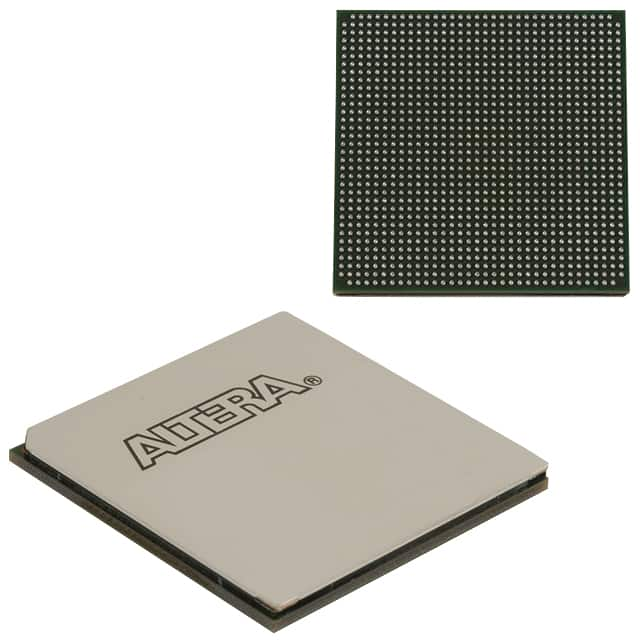Viz Specifikace pro podrobnosti o produktu.

5SGXMA3H3F35I3LN
Product Overview
Category
The 5SGXMA3H3F35I3LN belongs to the category of Field Programmable Gate Arrays (FPGAs).
Use
This FPGA is designed for high-performance applications that require complex digital logic circuits.
Characteristics
- High-speed processing capabilities
- Configurable logic blocks
- On-chip memory
- Flexible I/O interfaces
- Low power consumption
Package
The 5SGXMA3H3F35I3LN comes in a compact and durable package, ensuring easy integration into electronic systems.
Essence
The essence of this FPGA lies in its ability to be programmed and reprogrammed to perform specific tasks, making it highly versatile.
Packaging/Quantity
The 5SGXMA3H3F35I3LN is typically packaged individually and is available in various quantities depending on the customer's requirements.
Specifications
- Logic Elements: 220,000
- Embedded Memory: 8,848 Kbits
- DSP Blocks: 1,536
- Maximum User I/Os: 622
- Transceivers: 96
- Operating Voltage: 1.2V
- Operating Temperature: -40°C to 100°C
Detailed Pin Configuration
The 5SGXMA3H3F35I3LN has a comprehensive pin configuration with multiple pins dedicated to different functions. Please refer to the product datasheet for the detailed pin configuration.
Functional Features
- High-speed data processing
- Support for advanced algorithms
- Configurable I/O standards
- Built-in memory for efficient data storage
- Flexible clock management
- Integrated transceivers for high-speed data communication
Advantages
- Versatile and flexible design
- High-performance capabilities
- Low power consumption
- Easy integration into existing systems
- Extensive range of I/O interfaces
Disadvantages
- Steep learning curve for programming and utilization
- Relatively high cost compared to other solutions
- Limited availability of technical support
Working Principles
The 5SGXMA3H3F35I3LN operates based on the principles of reconfigurable logic. It consists of configurable logic blocks that can be programmed to perform specific functions using hardware description languages (HDLs) such as VHDL or Verilog. The FPGA's internal routing resources allow for the interconnection of these logic blocks, enabling the creation of complex digital circuits.
Detailed Application Field Plans
The 5SGXMA3H3F35I3LN finds applications in various fields, including:
- Telecommunications: Used in network infrastructure equipment for high-speed data processing and protocol handling.
- Aerospace and Defense: Employed in radar systems, avionics, and secure communication devices.
- Industrial Automation: Utilized in control systems, robotics, and machine vision applications.
- Medical Devices: Integrated into medical imaging equipment and diagnostic instruments.
- Automotive: Applied in advanced driver-assistance systems (ADAS) and infotainment systems.
Detailed and Complete Alternative Models
- 5SGXEA7K2F40C2N: Offers higher logic capacity and additional transceivers.
- 5SGXEB6R2F40C2N: Provides lower power consumption and enhanced security features.
- 5SGXEA5K2F40C2N: Offers a balance between logic capacity and power efficiency.
These alternative models provide different trade-offs in terms of performance, power consumption, and cost, allowing users to choose the most suitable option for their specific requirements.
Word count: 511
Seznam 10 běžných otázek a odpovědí souvisejících s aplikací 5SGXMA3H3F35I3LN v technických řešeních
Sure! Here are 10 common questions and answers related to the application of 5SGXMA3H3F35I3LN in technical solutions:
1. What is the 5SGXMA3H3F35I3LN FPGA used for? The 5SGXMA3H3F35I3LN FPGA is a high-performance Field-Programmable Gate Array (FPGA) that can be used in various technical solutions, such as telecommunications, data centers, industrial automation, and aerospace applications.
2. What are the key features of the 5SGXMA3H3F35I3LN FPGA? Some key features of this FPGA include a large number of logic elements, high-speed transceivers, embedded memory blocks, DSP capabilities, and support for various communication protocols.
3. Can the 5SGXMA3H3F35I3LN FPGA handle high-speed data processing? Yes, the 5SGXMA3H3F35I3LN FPGA is designed to handle high-speed data processing with its high-performance transceivers and advanced architecture.
4. How can the 5SGXMA3H3F35I3LN FPGA be programmed? The 5SGXMA3H3F35I3LN FPGA can be programmed using hardware description languages (HDLs) like VHDL or Verilog, or through graphical programming tools like Quartus Prime.
5. Does the 5SGXMA3H3F35I3LN FPGA support PCIe connectivity? Yes, the 5SGXMA3H3F35I3LN FPGA supports PCIe connectivity, making it suitable for applications that require high-speed data transfer between devices.
6. Can the 5SGXMA3H3F35I3LN FPGA be used for real-time signal processing? Absolutely! The 5SGXMA3H3F35I3LN FPGA's DSP capabilities and high-speed transceivers make it well-suited for real-time signal processing applications.
7. What is the power consumption of the 5SGXMA3H3F35I3LN FPGA? The power consumption of the 5SGXMA3H3F35I3LN FPGA depends on the specific implementation and usage scenario. It is recommended to refer to the device datasheet for detailed power specifications.
8. Can the 5SGXMA3H3F35I3LN FPGA be used in safety-critical applications? Yes, the 5SGXMA3H3F35I3LN FPGA can be used in safety-critical applications, provided that proper design and verification processes are followed to ensure reliability and functional safety.
9. Does the 5SGXMA3H3F35I3LN FPGA support high-speed serial communication protocols? Yes, the 5SGXMA3H3F35I3LN FPGA supports various high-speed serial communication protocols like Gigabit Ethernet, USB, SATA, and more.
10. Are there any development kits available for the 5SGXMA3H3F35I3LN FPGA? Yes, Intel (formerly Altera) provides development kits and evaluation boards specifically designed for the 5SGXMA3H3F35I3LN FPGA, which include necessary hardware and software tools to facilitate the development process.
Please note that the specific details and answers may vary depending on the context and requirements of the technical solution being implemented.

